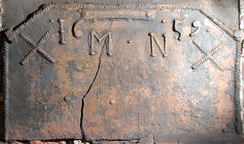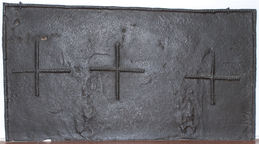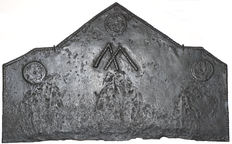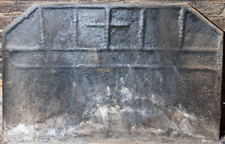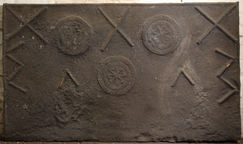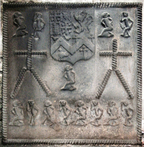-
725
Description: Canted rectangle with twisted rope edging; uneven, individually stamped letters and numerals, the initials separating the two parts of the date, which are raised slightly higher; dots are stamped on each side of each half of the date and between the initials; a twisted rope saltire at each end of the inscription.
Notes: The plate above the inscription is a repair, as are the rivets either side of the crack.
Inscription: ·16· M · N ·59·
- Decoration tags:
- rectangular with canted top corners (shape)
- rope (edging)
- simple stamps
- carved stamps
- individual letters
- individual numbers
- apotropaic
- text
- objects
Manufactured: in 1659 in the Weald area of England.
Current location: in private hands, Upper Beeding, West Sussex, England.
- Attached to series:
- Date & initials firebacks
- Rope design firebacks
- Shortened '5' series
-
728
Description: Quasi-rectangular; twisted rope edging (top and sides); across the centre, three crosses formed of the repeated stamping of a length of twisted rope.
Notes: The edging appears to have been formed of the same length of rope. The crosses almost certainly have Christian significance.
- Decoration tags:
- rectangular (shape)
- simple stamps
- apotropaic
- objects
Manufactured: in the 16th century possibly in the Weald area of England.
Current location: Victoria & Albert Museum, Cromwell Road, Kensington & Chelsea, Greater London, England.
Museum number: 887.1901 (part of the Victoria & Albert Museum museum group)
- Attached to series:
- Rope design firebacks
-
733
Description: Rectangular with canted top corners and a triangular extension from the top edge; twisted rope edges to all sides except bottom; a circular wafering iron or butter mould stamp, incorporating a square design with a fleur-de-lys on each side, repeated thrice, one at the apex and one below each of the canted corners; two inverted ‘V’ rope shapes overlapping to make an ‘M’ below top stamp.
Notes: The inverted double 'V' may be apotropaic, invoking the protection of the Virgin Mary; the circular stamp has also been noted on a Pelham-associated fireback of 1642 (no. 1204) which may suggest that it was a product of one of the family's ironworks.
- Decoration tags:
- rectangular with triangular arch (shape)
- rope (edging)
- simple stamps
- apotropaic
- objects
Manufactured: in the late-16th to early-17th century possibly at Waldron Furnace in the Weald area of England.
Current location: Victoria & Albert Museum, Cromwell Road, Kensington & Chelsea, Greater London, England.
Museum number: 895.1901 (part of the Victoria & Albert Museum museum group)
Citation: Page, S. & Wallace, M. (eds.), 2018, Spellbound (Oxford, Ashmolean Museum), p. 72.
- Attached to series:
- Food mould stamp firebacks
- Rope design firebacks
-
1278
Description: Canted rectangular shape; twisted rope edging (top and sides only; two approximately parallel horizontal lines of twisted rope across the upper centre; from the upper line and starting at the top corners, five regularly-spaced vertical lines of twisted rope extending to the top edge, the centre one with a horizontal rope length formiong a cross.
Notes: A simple rope design with apotropaic significance.
- Decoration tags:
- rectangular with canted top corners (shape)
- rope (edging)
- simple stamps
- apotropaic
- objects
Manufactured: in the mid- to late-16th century possibly in the Weald area of England.
Current location: in private hands, Wadhurst, East Sussex, England.
- Attached to series:
- Rope design firebacks
-
1042
Description: Rectangular; twisted rope edging (top and sides); top centre, twisted rope saltire between two food moulds used as stamps, comprising two concentric discs with a hatched design and enclosing four hearts arranged in a cross; below the saltire another food mould stamp; in the top corners, a twisted rope saltire with a double V design below each, the open ends facing inwards; below each of the upper pair of food mould stamps, an inverted twisted rope V.
Notes: The food mould stamps can be seen on another fireback dated to 1562; the rope Vs and saltires have an apotropaic, or evil averting, purpose.
- Decoration tags:
- rectangular (shape)
- rope (edging)
- simple stamps
- carved stamps
- apotropaic
- objects
Manufactured: in the mid-16th century in the Weald area of England.
Current location: Manor House, North Lane, West Hoathly, West Sussex, England.
Citation: Hughes, G. B., May 1940, 'Old English Firebacks', Apollo, 31, 185, pp. 117-120.
- Attached to series:
- Food mould stamp firebacks
- Heart cross stamp series
-
920
Description: Rectangular; twisted rope edging; top centre, quartered shield between four 'imp' figures, left facing, one with right arm raised, one of each on each side; below each pair of figures, a rope cross above an inverted V in rope, with an 'imp' figure, arms lowered, below the shield; along the bottom, eight 'imp' figures, alternately arms raised and lowered.
Notes: The 'imp' figures are common on a group of firebacks, the rope designs having a probable apotropaic significance. The arms are probably of Thomas Wriothesley, who was Henry VIII's last Lord Chancellor and created Earl of Southampton in 1547; he married c.1533 so the arms could date to before then, but the same arms are displayed on his enamelled stall plate in St George's Chapel, Windsor, of 1545, and in stained glass in a window in the parish church at South Warnborough, Hampshire. The shield is, quarterly, 1. Wrythe or Wriothesley quartering Dunstanville and Pink, 2. Drayton, 3. Crocker and 4. Peckham. The same armorial stamp has been noted on at least two other firebacks. A candidate for the earliest English fireback with an example of personal arms.
Arms: Wriothesley (Earl of Southampton)
- Decoration tags:
- rectangular (shape)
- rope (edging)
- simple stamps
- carved stamps
- apotropaic
- armorial
- humans
- objects
Manufactured: in the mid- to late-16th century in the Weald area of England.
Current location: in private hands, Wigmore, Herefordshire, England.
- Attached to series:
- Royal series
- Personal armorial firebacks
- Wriothesley firebacks
